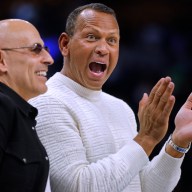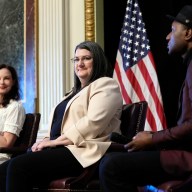 Wallace Shawn reunites with longtime collaborator Andre Gregory for the Ibsen adaptation “A Master Builder.”
Wallace Shawn reunites with longtime collaborator Andre Gregory for the Ibsen adaptation “A Master Builder.”
Credit: Getty Images
To most, Wallace Shawn is the scene-stealing, short, nasal-voiced supporting player in “The Princess Bride,” “Clueless” and the “Toy Story” films. To the theatrical world he’s someone else entirely: a controversial playwright, whose piece “A Thought in Three Parts” was investigated by the London vice squad in 1977.Of course, he’s also known to film fans for 1981’s “My Dinner with Andre,” in which he and Andre Gregory spent a film chatting over a fine meal. He and Gregory have frequently collaborated, including in the 1994 “Uncle Vanya” film “Vanya on 42nd St.”
Shawn and Gregory return to the screen again with “A Master Builder,” a loose update on Henrik Ibsen’s “The Master Builder,” in which Shawn takes the role of an arrogant, duplicitous, dying architect chatting with a young woman (Lisa Joyce) who may have been his onetime lover.
What motivated you and Gregory to move this play over to film?
Ibsen didn’t have the opportunity to make films, because unfortunately he died before film was invented. But had he lived I think he might well have wanted to do some of his work in film, because some of his plays, particularly this one, are very intimate, very quiet. They really take place inside people’s heads. Of course you could do them on a large stage with everyone shouting. But the characters are sharing very intimate thoughts. Film is very suited to that.
Film also affords viewers the chance to really study the actors’ faces as they think through their characters’ thoughts.
Absolutely. In theater you don’t see people’s faces as well as you do in a film.
The cameras in “A Master Builder” are so close to the actors. It’s reminiscent of some of the experimental theater pieces you and Gregory have done in small theater spaces, and in some cases actual apartments.
Andre and I would never have done this in a big theater. If we were going to do it in a theater at all it would have been for 25 people, because the style of acting that we’re used to when rehearsing was essentially film-style acting, where you don’t project your voice and you don’t worry about reaching the people in the back row. The back row is the third row.
Are you against doing bigger theater in general?
There can be a very enjoyable type of theater that is more artificial. In the recent production of “Twelfth Night” [on Broadway], it was done in an old-fashioned way, with men playing women, like Mark Rylance, and they projected their voices so you could hear the whole thing from quite far away. That’s a particular style of theater. But for the most part a lot of what Andre and I have done is more naturalistic. That can be exciting because there’s a limit to how natural you can be when you’re projecting your voice.
Do you feel all Ibsen requires such an intimate performance style?
“Hedda Gabler” is fantastic on stage, and “A Doll’s House” is fantastic on stage, and I’m sure in gigantic theaters. But this particular play is more a dream-play.
 Wallace Shawn plays an architect visited by a woman who may be a long-lost love in “A Master Builder.”
Wallace Shawn plays an architect visited by a woman who may be a long-lost love in “A Master Builder.”
Credit: Bob Vergara/Abramorama
Why did you choose to do a new translation of “The Master Builder” yourself?
I’ve generally found that translations of Ibsen are heavy, a little dull, they’re not conversational and they use words that are often old-fashioned and sometimes a little crude. You think Ibsen was crude or he wasn’t very bright, or the characters weren’t very bright. Well, they should be. Ibsen was unimaginably brilliant. Our version of Ibsen includes Ibsen’s humor, which is often left out of a lot of the productions I’ve seen and a lot of the translations I’ve read. He has a great sense of humor. I was quite excited to leap into that writer and see how he put the play together — to pretend I was writing a play by Ibsen. You could say that’s very arrogant. But I am arrogant.
You also update this to a vague modern day. What connections do you see with “The Master Builder” and right now?
In some ways it can’t be the modern world. It’s its own world. We’ve taken it out of Norway but we haven’t exactly put it in the year 2014. There’s no one like Mrs. Solness in our world. But there are a lot of people like Mr. Solness. He’s the classic controlling male. He’s like an imperialist, the one who gets excited by the thought of dominating. There’s a little Dick Cheney in that character.
You started rehearsing for this film in 1997. Was it good that it took so long to get the film mounted?
It took a long time simply to understand the play. When we first did it, after every rehearsal we would sit there in amazement and say, “My god, that is so weird. What a weird play.” And after a few years we stopped saying that. It didn’t seem weird anymore. We must have become weird.
Do you do that often: take lengthy periods to really get to know plays before presenting them to audiences?
I’ve only done that with “Uncle Vanya,” “The Master Builder” and then my own plays that Andre has directed. In all of the cases, they’ve been pretty complicated works and it does take time to get inside them — strangely, even with the things I wrote myself. It’s like a different part of me is acting in them than the one that wrote it. And your first reading of any play or book or whatever it might be is heavily colored by all the things you think already. There may be a lot in that book or play or individual speech in a play that you don’t really hear or see the first time around. Instead you’re laying on top of it your own sometimes very shallow and stupid ideas about what it must mean.
When you return to your old plays, do you find yourself in dialogue with a different, younger version of yourself.
I put that writer out of my mind. I don’t think too much about the guy who wrote it. I find it similar to acting in other people’s things. It’s a remarkably similar process in a funny way, even when we did “My Dinner With Andre” and we were theoretically playing ourselves. It honestly isn’t that different from playing the dinosaur in “Toy Story.”
Despite your long theatrical history, you’re best known to most for supporting roles in comedic films. How did you wind up being cast in such roles in the first place?
I suppose it might have to do with being short. People don’t take short people seriously, usually. Maybe if I had been the same person but six feet tall I would have been cast in tragic roles, primarily. I don’t know. Short people are usually seen as less than fully human, and that’s what comedic parts usually are. They’re sort of incomplete people and they play small parts in the story of the big, serious people. I’m cast as short even if I’m doing a cartoon.
Follow Matt Prigge on Twitter @mattprigge
















